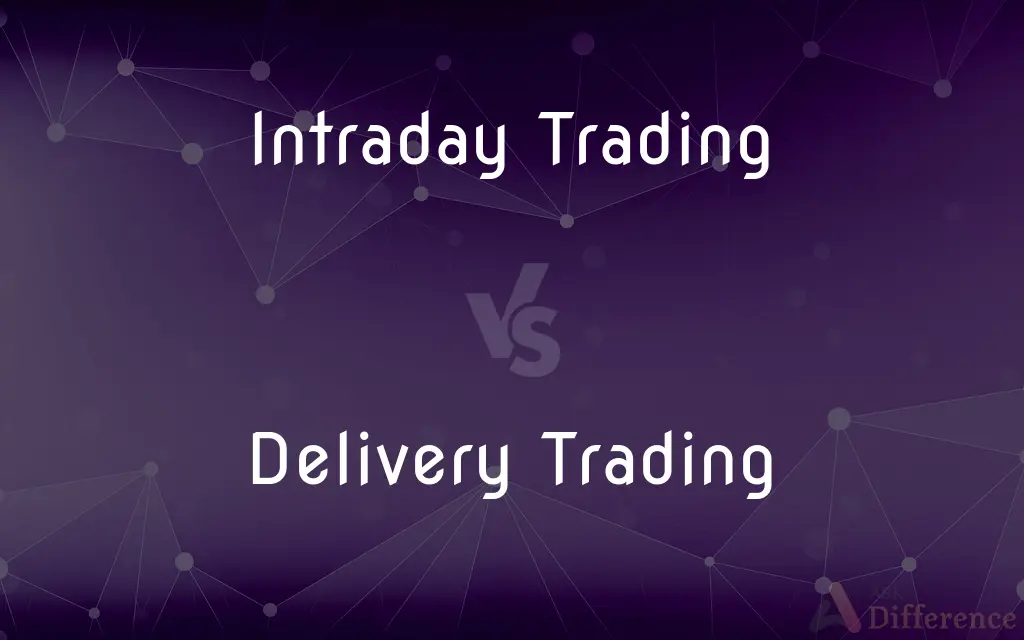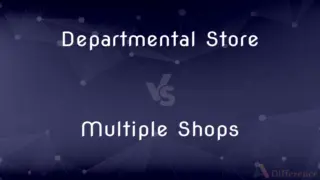Intraday Trading vs. Delivery Trading — What's the Difference?
Edited by Tayyaba Rehman — By Fiza Rafique — Published on December 6, 2023
Intraday Trading involves buying and selling stocks within the same trading day. Delivery Trading means buying stocks and holding them beyond the trading day.

Difference Between Intraday Trading and Delivery Trading
Table of Contents
ADVERTISEMENT
Key Differences
Intraday Trading is a type of stock market trading where investors buy and sell shares within the same trading session. The primary goal is to capitalize on short-term price fluctuations. Conversely, Delivery Trading refers to the practice of purchasing shares and taking delivery of them, intending to hold them for an extended period, often days, weeks, or even years.
Intraday Trading requires constant monitoring of the market as the trader aims to benefit from small price movements. Such traders must be quick in decision-making and act promptly to book profits or cut losses. In contrast, Delivery Trading is less about timing the market on a minute-to-minute basis and more about believing in the fundamental strength of the purchased asset.
A distinctive feature of Intraday Trading is the use of leverage or margin provided by brokers, allowing traders to buy more shares than they could with their capital. In Delivery Trading, investors usually purchase shares with their own money without relying on borrowed funds.
While Intraday Trading can offer quick returns, it comes with higher risks due to market volatility within short time frames. Delivery Trading, on the other hand, might offer relatively stable returns as it allows for long-term investment and can potentially ride out short-term market fluctuations.
In terms of charges, Intraday Trading often has lower brokerages compared to Delivery Trading. However, in Delivery Trading, investors might incur additional charges like demat charges, which are fees for holding the shares in electronic form.
ADVERTISEMENT
Comparison Chart
Time Frame
Same trading day
Beyond one trading day
Objective
Benefit from short-term price fluctuations
Long-term investment
Leverage Use
Commonly used
Rarely used
Monitoring
Constant and intensive
Less frequent
Charges
Lower brokerage, no demat charges
Higher brokerage, potential demat charges
Compare with Definitions
Intraday Trading
Speculative trading where positions are squared off before market close.
Intraday Trading can be rewarding but is not for the risk-averse.
Delivery Trading
Buying stocks and holding them for more than one trading session.
He believes in Delivery Trading for building long-term wealth.
Intraday Trading
Stock trading strategy targeting quick profits from daily price shifts.
Despite its risks, many are drawn to the allure of Intraday Trading.
Delivery Trading
Stock buying practice focused on asset fundamentals rather than short-term trends.
Through Delivery Trading, he amassed a diversified stock portfolio over the years.
Intraday Trading
Short-term stock trading based on minute-to-minute price changes.
Intraday Trading requires a keen eye on market movements.
Delivery Trading
Long-term investment strategy in the stock market.
Delivery Trading is ideal for those with a vision beyond daily price changes.
Intraday Trading
Buying and selling of stocks within a single trading session.
He made a decent profit through Intraday Trading today.
Delivery Trading
Taking physical or electronic possession of shares after purchase.
For her retirement plan, she prefers Delivery Trading over short-term trades.
Intraday Trading
Act of leveraging short-term stock price volatility.
She excels in Intraday Trading because of her quick decision-making skills.
Delivery Trading
Purchasing shares with the intent to retain them in one's portfolio.
Delivery Trading is often seen as a safer bet compared to speculative trades.
Common Curiosities
What is Intraday Trading?
Intraday Trading involves buying and selling stocks within a single trading day.
How does Delivery Trading differ from Intraday Trading?
Delivery Trading means buying stocks and holding them beyond the trading day, whereas Intraday Trading concludes within the same day.
Is Intraday Trading riskier than Delivery Trading?
Intraday Trading can be riskier due to short-term market volatility, while Delivery Trading might mitigate such short-term risks with a longer horizon.
Do I need constant market monitoring for Delivery Trading like Intraday Trading?
No, Delivery Trading typically requires less frequent monitoring compared to Intraday Trading.
Can I use leverage in Delivery Trading?
While leverage is common in Intraday Trading, it's rarely used in Delivery Trading.
Can I convert my Intraday Trading position to Delivery Trading?
Yes, by opting to not square off your position by day's end, it can be converted to Delivery Trading.
Which trading type incurs higher brokerage fees?
Delivery Trading usually has higher brokerage fees than Intraday Trading.
Can short-term market news impact Intraday Trading more than Delivery Trading?
Yes, Intraday Trading is more sensitive to immediate market news and events compared to Delivery Trading.
Do I need a Demat account for both Intraday and Delivery Trading?
While a Demat account is essential for Delivery Trading, it's not mandatory for Intraday Trading since positions are squared off the same day.
How quickly can I expect returns from Intraday Trading?
Intraday Trading targets short-term price fluctuations, so returns (or losses) can be realized within the same day.
Is long-term investment the primary focus of Delivery Trading?
Yes, Delivery Trading emphasizes long-term holding and investment.
Share Your Discovery

Previous Comparison
Viable Particles vs. Nonviable Particles
Next Comparison
Departmental Store vs. Multiple ShopsAuthor Spotlight
Written by
Fiza RafiqueFiza Rafique is a skilled content writer at AskDifference.com, where she meticulously refines and enhances written pieces. Drawing from her vast editorial expertise, Fiza ensures clarity, accuracy, and precision in every article. Passionate about language, she continually seeks to elevate the quality of content for readers worldwide.
Edited by
Tayyaba RehmanTayyaba Rehman is a distinguished writer, currently serving as a primary contributor to askdifference.com. As a researcher in semantics and etymology, Tayyaba's passion for the complexity of languages and their distinctions has found a perfect home on the platform. Tayyaba delves into the intricacies of language, distinguishing between commonly confused words and phrases, thereby providing clarity for readers worldwide.












































